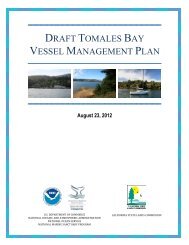Symposium program - Gulf of the Farallones National Marine ...
Symposium program - Gulf of the Farallones National Marine ...
Symposium program - Gulf of the Farallones National Marine ...
Create successful ePaper yourself
Turn your PDF publications into a flip-book with our unique Google optimized e-Paper software.
Nicole Nasby-Lucas and Michael L. Domeier<br />
<strong>Marine</strong> Conservation Science Institute, 2809 S. Mission Rd, Ste G, Fallbrook CA 92028<br />
Use <strong>of</strong> photo identification to describe a white shark aggregation in <strong>the</strong> eastern Pacific<br />
(Guadalupe Island, Mexico)<br />
White sharks, Carcharodon carcharias, aggregate annually around Guadalupe Island, Mexico. To document<br />
and monitor individual white sharks present at <strong>the</strong> island, a system <strong>of</strong> photo-identification (photo-ID) was<br />
developed which identifies individual sharks by <strong>the</strong>ir color patterns. Using this system we have compiled a<br />
catalog <strong>of</strong> 107 white sharks from Guadalupe Island between 2001 and 2008. 81% <strong>of</strong> <strong>the</strong> sharks in our catalog<br />
have been sighted in at least two years, with 52% <strong>of</strong> <strong>the</strong> males and 33% <strong>of</strong> <strong>the</strong> females being sighted at <strong>the</strong><br />
island at least four years. We examined <strong>the</strong> every-o<strong>the</strong>r year residency patterns <strong>of</strong> sexually mature females and<br />
<strong>the</strong> presumed 18 month gestation cycle for white sharks and found that during this study period 69% <strong>of</strong> <strong>the</strong><br />
females exhibited an every o<strong>the</strong>r year visitation pattern at least once with some sexually mature females that had<br />
previously returned on an every o<strong>the</strong>r year cycle being sighted in consecutive years, indicating that females may<br />
not get pregnant each year. This data in conjunction with satellite tag tracking data will help to answer important<br />
questions on <strong>the</strong> migratory patterns and life history <strong>of</strong> this threatened species.<br />
Nadia Citlali Olivares Bañuelos<br />
Reserva de la Biosfera Isla Guadalupe Comisión Nacional de Áreas Naturales Protegidas Av. Del Puerto F375-30<br />
Fracc. Playa Ensenada, C.P. 22830, Ensenada B. C., México<br />
White shark, a protected species in Guadalupe Island Biosphere Reserve;<br />
management and monitoring<br />
White shark, Carcharodon carcharias, is part <strong>of</strong> <strong>the</strong> pelagic-coastal and oceanic shark assemblages that<br />
regularly visit Guadalupe Island Biosphere Reserve, under <strong>the</strong> Comisión Nacional de Areas Naturales<br />
Protegidas (CONANP). In Mexico, white shark is included in <strong>the</strong> Mexican Official Regulation NOM-059-<br />
SEMARNAT-2001, for Environmental Protection <strong>of</strong> wild native Flora and fauna species <strong>of</strong> Mexico; and NOM-<br />
029-PESC-2007 for Responsible Fishing <strong>of</strong> Sharks and Rays, along with o<strong>the</strong>r shark and ray species vulnerable<br />
to overfishing, in a chapter for special protection. Both regulations protect and forbid capture, fishing and<br />
killing <strong>of</strong> any white shark in Mexican waters, because <strong>the</strong>ir life history (low reproductive potential, late sexual<br />
maturity, slow growth rate and an extended longevity) makes <strong>the</strong>m an extremely vulnerable species. O<strong>the</strong>r<br />
management, protection and conservation tools are <strong>the</strong> Creation Decrees and Management Programs for<br />
Natural Protected Areas, where all regulations, management, protection and conservation actions, surveillance<br />
and law enforcement are widely described. Internationally, this species also have been included in <strong>the</strong> Appendix<br />
II <strong>of</strong> CITES which include species not necessarily threatened with extinction but in which trade must be<br />
controlled in order to avoid use incompatible with <strong>the</strong>ir survival. Due to <strong>the</strong> presence and abundance <strong>of</strong> this<br />
species in <strong>the</strong> surrounding waters <strong>of</strong> <strong>the</strong> Reserve, and Mexican regulations for its protection and conservation, it<br />
has been necessary to implement protection and management measures especially in regards to all <strong>the</strong> activities<br />
that develop around it such as white shark cage diving, photography and filming, and research. These procedures<br />
mentioned above have been applied since <strong>the</strong> decree <strong>of</strong> <strong>the</strong> Reserve on 2005, and have been upgraded specifically<br />
using <strong>the</strong> information derived from <strong>the</strong> white shark observer <strong>program</strong> on board <strong>the</strong> tourist vessels that carry<br />
out <strong>the</strong>se activities in <strong>the</strong> Reserve. This <strong>program</strong> has provided information in regards to white shark surface<br />
observations for four years.<br />
John B. O’Sullivan 1 , Kevin Weng 2 , Chuck Winkler 3 , Christopher G. Lowe 4 , Salvador Jorgensen 5 , Oscar Sosa-<br />
Nishizaki 6 , Manny Ezcurra 1 , Barbara Block 5 and Angela Hains 1<br />
1<br />
Monterey Bay Aquarium, 886 Cannery Row, Monterey, California 93940<br />
2<br />
University <strong>of</strong> Hawaii, 1000 Pope Road, Honolulu, HI 96822<br />
3<br />
Aquatic Research Consultants, 2131 Vallecito Dr., San Pedro, CA 90732<br />
4<br />
California State University, Long Beach, 1250 Bellflower Blvd, Long Beach, California 90840<br />
5<br />
Hopkins <strong>Marine</strong> Station, Stanford University, 120 Ocean View Blvd, Pacific Grove CA 93950<br />
6<br />
Laboratorio de Ecología Pesquera, Departamento de Oceanografía Biológica, CICESE, Km 107, Carretera Tijuana-<br />
Ensenada, Ensenada, Baja California, México, C. P. 22860<br />
The Monterey Bay Aquarium’s Juvenile White Shark Project: How weaving toge<strong>the</strong>r partners<br />
from <strong>the</strong> scientific and fishing communities with research, conservation and education messaging<br />
created a wildly successful <strong>program</strong>







